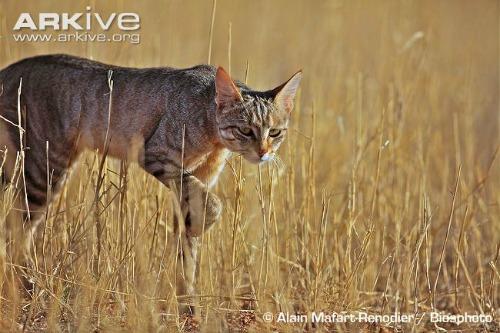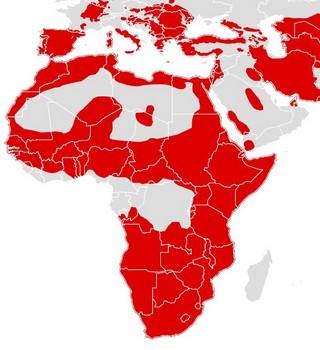- Head Body Length: 45-80 cm (17-31″)
- Tail Length: 24.1-36.8 cm (9.4-14″)
- Weight: 3-8 kg (6-18 lbs)
The African Wildcat Felis lybica is the size of a large housecat. They have longer legs than the domestic cat, giving them a more upright posture in the sitting position and a different walking form. The background color of its coat ranges from reddish to sandy yellow to tawny brown to grey, and is typically marked with faint tabby stripes and spots. Hairs have black tips giving a speckled appearance, and their legs are banded with black bars. A characteristic feature of this group is a reddish or rusty-brown tint to the backs of the ears. The long, thin tail ends with 2 or 3 black rings and a black tip. There is a line of darker fur down the spine from the shoulder to the base of the tail. Paw pads are black like those of the black-footed cat. The African species distinguishes itself from the European Wildcat by its lighter build, less distinct markings and thin tapering tail.
This cat varies locally in appearance. In general, from north to south there is a gradation of coat thickness, intensity of ground color, and amount of “tabby” markings.
There are two main features that can help distinguish wildcats from domestic cats and hybrids. One is the rich reddish brown on the backs of the ears. Domestic-wild crosses usually have dark gray or black-backed ears, but sometimes retain a little red at the base. A second striking characteristic is the wildcat’s long legs. When the wildcat is sitting upright, its long front legs raise its body into an almost vertical position. This characteristic pose, which is almost impossible for domestic cats or crosses, can be seen in the ancient Egyptian bronze mummy cases and tomb paintings. Even when walking the wildcat’s long legs and high shoulder blades give it a distinctive action; it moves more like a cheetah than a domestic cat.
Distribution
This wildcat has a very wide distribution, found throughout most of Africa, southwest and central Asia into India, China, and Mongolia. It is found in most parts of Africa and around the periphery of the Arabian Peninsula to the Caspian Sea. It is present in all east and southern African countries. In North Africa they occur discontinuously from Morocco through Algeria, Tunisia, and Libya into Egypt. In West Africa it is widely distributed from Mauritania to the Horn of Africa, Sudan and Ethiopia.
The African wildcat has a very broad habitat tolerance and is found from deserts, semi deserts, savannahs, scrub grassland to open forests in hilly and rocky terrain as well as in mixed forests. It seems to be absent only from tropical rainforest. In the Nubian, Saharan and Arabian deserts, it seems to be restricted to mountains and dry watercourses. In Kenya, Ethiopia and Algeria, it has been recorded at over 3,000 m elevation.
Ecology
This is a solitary species but can form temporary large groups comprised of a female with her offspring from several consecutive litters. It is mainly nocturnal, especially in very hot environments or in proximity to settled areas but it can also be active in early mornings or late afternoons. It hunts primarily on the ground but it is an excellent climber. It gets its prey by stalking followed by a quick attack. Since the wildcat depends mainly on rodents, which undergo large cyclic changes in populations, it must be able to frequently produce large litters to withstand these prey base fluctuations.
The wildcat is territorial and uses scent marks for communication. In the United Arab Emirates, the home range of one female was quite large at 52.7 km². In South Africa female home ranges of 6-10 km² were recorded in the Kalahari Gemsbok National Park. The home range of one male African wildcat near the Nakuru in Kenya was 4.3 km².
The main prey species are rodents such as rats, mice and voles. It also hunts insectivores, hares, rabbits, birds, insects, frogs, lizards, fish and occasionally martens, weasels, polecats, and poultry. The wildcat can also prey on young antelopes and small livestock (lambs, goat kits). It is also known to be a scavenger.
Reproduction
The birth season in southern Africa is from September to March. In the northern Sahara breeding takes place from January to March. Gestation lasts for 56-68 days and at 9-12 months the wildcat reaches its sexual maturity. When the female is in heat, it only allows one male in its territory. Longevity is up to 16 years.
Conservation
Hybridization with domestic cats is considered the main threat to the wildcat. Evidence of such cross-breeding has been found in southern and northern Africa. Hybridization may have been taking place over a long period of time, and it is possible that very few genetically pure African wildcats still exist. Pure genetic populations may only persist in protected areas far from human settlements. Feral domestic cats compete with wildcats for prey and habitat. Wildcats can also suffer from diseases transmitted by domestic cats.
Wildcats are also killed by vehicles, as bycatches of predator control measures, or by rodenticides. In southern Africa, they are persecuted as pests due to poultry and lamb predation.
The wildcat can live in agricultural or cultivated landscapes dominated by humans if enough rodents are available. However, such habitats are also where hybridization takes place and spreads. Therefore, it is important to identify genetically pure African wildcats and assure their protection to prevent hybridization or disease spread from domestic cats. The difference between wild and domestic cats is however complicated and difficult to assess, particularly in the field.
An International Studbook aims to record the captive individuals of the subspecies distributed in Oman and the United Arab Emirates, the Gordon’s wildcat (F. l. gordoni), which is threatened via hybridisation and human encroachment of the desert environment.
The wildcat is included in Appendix II of CITES but it is not protected over most of its range in Africa. The wildcat (including Felis silvestris and Felis lybica) is considered as Least Concern in the IUCN Red List of Threatened Species. The species Felis lybica has not yet been separately assessed in the IUCN Red List.
Updated 2018
Range map courtesy IUCN Red List
See also
Asiatic Desert Cat F.l. ornata


Susan Sposato
I’m pretty sure that I have one. Some horrid person left a litter of 5 newborn kittens on the side of a road
They were rescued and I adopted two of them.
I believe that they have different fathers because, one is a tuxedo tabby but, the other one looks exactly like a felis lybica.
So much so, that I swear the photos of these wild cats are photos of him.
Even the vet is stumped as to his breed.
He is the most beautiful, loving kitty! He’s so exotic looking!
Jade
I am pretty sure I had one in northeast Kenya. His name was Jazz. I rescued him as a couple day old orphan, my yellow labrador/Rhodesian ridge-back cross helped me raise him. He was a hybrid because he was white & black, but he had the longest body & legs I have ever seen. His head would reach the kitchen counter when he stood up. Big pointy ears too. He killed everything! Kept snakes & mice down around the house. & even as a kitten he pounced on a full-size pigeon, it took him up into the air for a bit & then, crashed into my Labrador’s mouth. She had watched the action & decide to help Jazz kill it. Funniest thing I have ever seen. He was raised by my lab so he would sleep around the house & yard like a fat labrador. Even adopting the front legs splayed out either direction with his head down the middle position. He could definitely put the hurting on you. At night he’d get these moods to chase you down like a mini cheetah & tear up your calves & thighs. Just shred you up. Normally he was very affectionate, but at night you had better be paying attention. I swear he almost gave me a heart attack on some occasions.
Valerie
I have been priviledged to have 2 African wild cats as our family pets .One in 1982 in Newcastle KZN. The 2nd one I found on a golf course also in KZN. Sadly both now are gone.The most recent one we had for 11 years+sadly just passed away.Both of them had such lovely characters. The only differences to domestic cats I found was that their back legs were exceptionally strong+if you went to play,those back legs+claws got a bit more serious than domestic cats, also they were very fadt at snake catching! Luckily I have lots of photographs of them+their beautiful markings.
Pat Bumstead
Some experts can tell from the patterning on the cat but the most conclusive answer would be to do genetic testing.
Pamela-anne Dolan
How do you tell the difference between a african wild cat and a hybrid
Alessandra Berardi Arrigoni
Hello. I would like to let you know that Felis Lybica also lives in Sardinia (Italy), where it is commonly known as “gattu areste” (wild cat). For some scientists, this elusive animal living in woods of the large island is a Subspecies of Felis Lybica (Sardinian Felis Lybica). I live with one of them, found when he was a 10-day old kitten, and later revealing to be a wildcat. I call him “Doctor Cat and Mister Wild”. He is very sweet to me, but would assault whoever comes in the house, so I made separated indoor and outdoor areas for him, to keep visitors safe. He understands a lot of different sentences, and is a very affectionate creature.
Pat Bumstead
Sorry but there are no population numbers for any of the wildcats, including the African Wildcat and Gordon’s Wildcat. The African Wildcat lives in such a huge range in so many countries it would be impossible to study them all.
Www.saveacat.org
Where can I find population numbers for African Wildcats in different regions ?
Les Mitchell
Thanks for the up-dates, very interesting so is the flag count